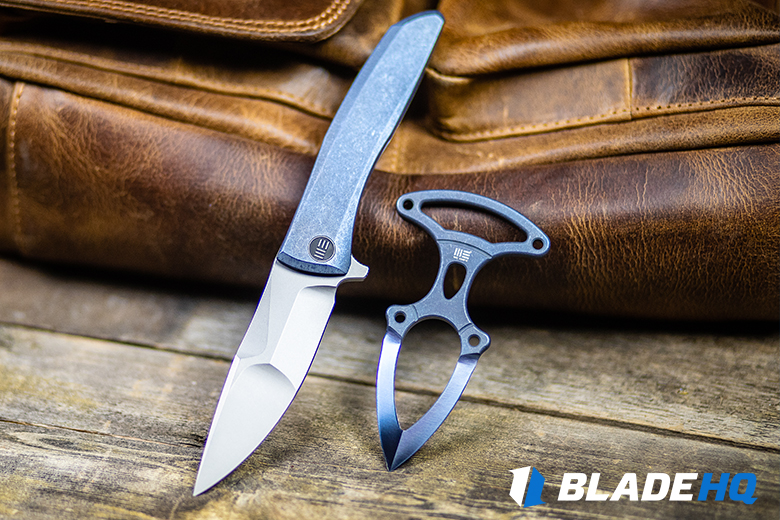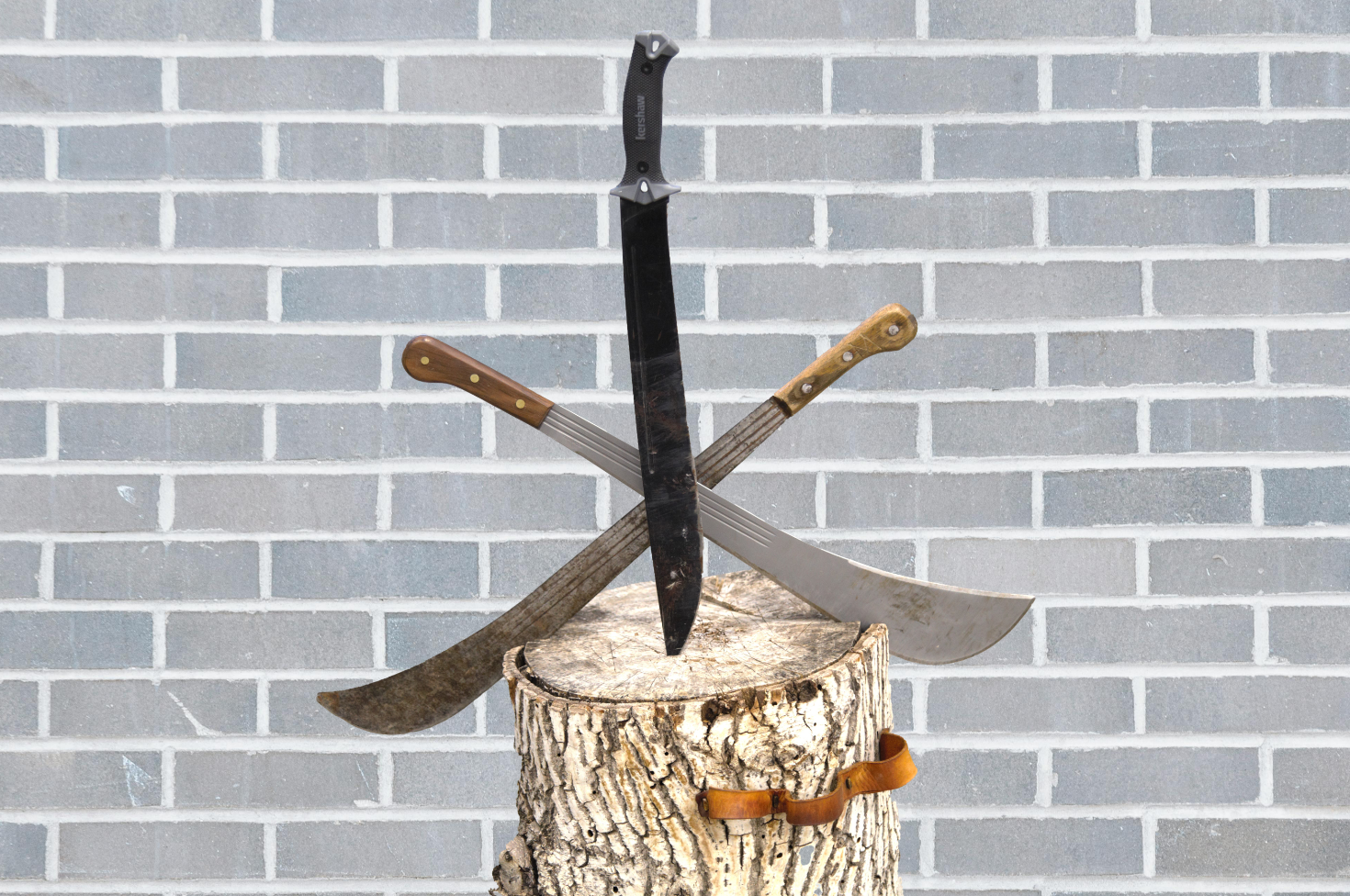
When you start out acquiring your knife collection, it’s easy to be swayed by inconsequentials. Of course, you want your knife to be appealing in terms of design, but sometimes in our enthusiasm over the latest shiny creation we blade fans can forget the fundamentals of ownership—what are you actually going to use it for? In other words, as the old saying goes, don’t buy a stiletto for your machete sheath. (Actually, we just made that up, but we’re hoping it catches on.) Purpose should have a lot to do with your decision making. Collectors tend to look at steel, blade shape, blade length, and edge—but forget grind. So, we’ve come to spread the message: don’t neglect grind!
One grind that supplies a superb edge for skinning may not be the best option when you’re ready for some hardcore batoning.
But don’t worry; it’s easier to learn than it sounds. Let’s jump in.

1. Hollow Ground
Hollow grinds are great for getting razor sharp edges.
When knife fans gush over a “slicey” knife, often the blade in question has a hollow grind. A hollow ground blade features a concave curve from a spot below the spine down to the edge. A popular example of this would be the CIVIVI Elementum which has a beautifully sharp hollow grind that’s also super durable because of premium materials. For your hunting and outdoors knife, there’s also the Buck 110 which has been beloved for over fifty years for good reason. It’s great for skinning game, food prep, and a bunch of everyday tasks that are sure to come up.
Bonus? As you sharpen your hollow grind knife, the thickness at the edge of your knife stays consistently thin rather than getting thicker behind the edge with every sharpening. When people say a knife is “razor sharp,” think hollow—razors are hollow ground.
Best at slicing, but not so great at heavy-duty chopping. Planning on using this blade as a machete? There’s a good chance of chipping—or worse—if you misuse a hollow grind like this.

2. Flat Ground/Full Flat Ground
Flat grinds are great for whittling and general use.
This is an easy one—it looks just like it sounds. A flat grind goes from a spot below the spine of the blade to the cutting edge in a symmetrical V shape. Another less-common variation is the full flat grind that extendes from the spine to the cutting edge. You will commonly see full flat grinds labeled FFG. A full flat grind can also be called a high flat grind. Flat and full flat grinds make for a great all-around blade that’s a dream to sharpen, has admirable strength, and can be used for woodworking and chopping—as long as the blade steel is thick enough. This is another knife grind that’s also at home in the kitchen. Truthfully, the flat is a great grind for just about every blade, but especially shines in Spyderco who’s known for its use. We are particularly fond of our exclusive, the Spyderco Shaman in green micarta. Just a great knife from the blade to the hardware. In fixed blades, Bradford Knives makes some gorgeous, well-priced flat ground pieces.
A flat ground knife, unlike the hollow, tend to thicken behind the edge after several dozen rounds of sharpening. Eventually, your blade may need a thorough thinning, but that’s a lot of sharpening until then.

3. Scandi // Sabre // V-Grind
Scandi and Sabre/V-Grinds are often found on outdoor bushcraft knives.
From our Scandinavian friends, as the name implies, the Scandi grind is popularly found on fixed blades and knives designed for whittling and other woodwork. The knife remains rectangular (unground) until you hit part-way down the blade, and then the grind turns into a V. All other grind styles feature an edge bevel, but not the Scandi! This grind has become popular as a Bushcraft knife because it takes on batoning like a champ, but keep in mind that this blade is not ideal for slicing and food prep. If you expect a bushcraft knife to handle everything and anything at your campsite, you might be disappointed. However, this grind is easy to sharpen, and the thickness makes for a strong blade. When you need strength, the Scandi is your knife. Tops Knives is known for their fixed blades, as are Swedish brands Fallkniven and Morakniv—all phenomenal examples of the Scandi grind.

4. Convex // Hamaguri
Convex grinds have a strong edge due to the thicker steel behind them.
When you look at a hollow blade and think, “I want the exact opposite of this,” then you, my friend, want a convex grind. Instead of a concave grind which minimizes the material close to the edge, the convex grind places the maximum amount of material at the edge. This style of grind is great for hard-use fixed blades and a variety of folding knives as well. Machetes and axes are usually convex, such as those usually found in the Hult Bruks. The gentle curve protects the edge and acts as a wedge to split the wood apart. The slightly rounded edge tapers, making for a durable, hard-wearing blade.

5. Chisel
Chisel grinds are strong and easily sharpened.
You may think your knifemaker took a half-day when you look at a chisel, because one side isn’t ground at all. The result makes a popular tactical knife, but it’s also great for woodworking or food preparation—it’s usually found in Japanese cuisine. Accurate cuts can be difficult, but the added strength is a huge plus. Knife maker Ernest Emerson is well known for his preference for chisel blades because he believes they’re stronger than all the rest and there’s no drag from the flat side.
Popular chisel blades are the Emerson Pro-Tech and several of the knives available in Joey Roman Knives.

6. Compound Bevel
Compound bevels can be less prone to chipping than single bevel blades.
A compound grind features any two different grinds from this list. When you combine two separate grinds, you can reap the benefits of both of their strengths. A compound bevel prevents chipping or edge turning and is popular for its added durability and style. The resulting blade tends to be stronger than a traditional, full flat grind. You may not realize that the tanto blade features a compound bevel grind—usually a Scandi/hollow combination. The hollow grind makes the tanto sharp and slicey, while the scandi or sabre grind makes it hackworthy. A great example of this is the exquisitely designed Chaves Redencion 229. Every knife collector should have a Chaves, and this compound grind is a beauty! Another great example is the CIVIVI Thug—a workhouse compound grind that bites its way through every task with strength and super-slicey action.

7. Asymmetrical
Asymmetrical grinds can combine the best of different angles to create a durable edge.
Asymmetrical grinds feature two different grinds on each side of the blade. In a world that values symmetry, it’s no surprise that the asymmetrical grind is the rarest type out there. They are seriously hard to find. The grind, however, is easy to sharpen, and the resulting edge is less likely to chip. If you’re going tactical, the asymmetrical blade is known for its hard-wearing strength and durability, while still being sharp. If, however, you are someone who constantly rearranges the items on your mantlepiece to make them more symmetrical—it’s probably not for you.
The unique CIVIVI Orthrus is an excellent example of an asymmetrical blade that would be the talking point of any collection.
CONCLUSION
Now that you’re an expert on blade grinds, do you have a preference? Or are you like us and want to have at least one of each? Because we can make that happen. (No need to thank us, it’s what we’re here for.)
Something to keep in mind: when trying out a new blade, the steel should match the grind. For instance, if you’re looking at a convex ground axe, the steel should match in durability. Luckily, we deal with expert knifemakers who tend to think of details like compatibility way before the blade gets anywhere near our website.
Let us know what grind you prefer and what knife you think is the best example of its kind. Pull up a chair—we always love hearing from you.
We knife folk have to stick together.
Keep in contact with us on our Instagram, Facebook, and Twitter pages. We’ll be featuring all the latest and greatest in the knife world and answering all your blade questions. Check out the new content on our blog, too! We’re having a blast sharing what we learn.
LEARN MORE
If you’re yearnin’ for some more learnin’, check out our video below as Tyson and Mike dive more into knife grinds and show some popular models.
OTHER BEST KNIFE GUIDES
Still in that information gathering phase? We’ve got a bunch more guides on many different topics! Happy hunting and may you find that one special knife of your dreams.



